Diary Entry
After a relaxing stay in the famous Halong Bay, we turn around to reach Hanoi, which we passed earlier. We make two stops along the way. First, at a porcelain factory that produces beautiful vases, plates, and other porcelain items.
Clay is shaped and, once solid, artistically painted by the women, in fine lines and the most beautiful patterns. Those who aren’t completely engrossed in their work smile at me as I look over their shoulders.
Above us the sky opens again and the monsoon almost drowns us.


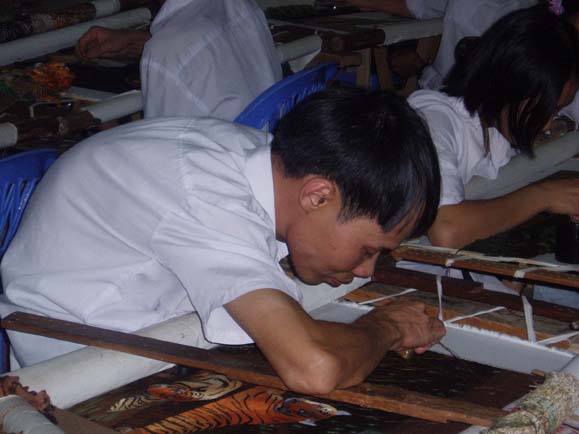
Second, we stop at a place that provides a good life for children with disabilities. What started as a small project has grown into a beautiful, large arts and crafts workshop. Here, children with disabilities are welcomed and cared for. They can attend school and also learn to sew, paint, make jewelry, or create beautiful embroidery.
These items are sold there and, admittedly, are made with a level of craftsmanship I haven’t seen anywhere else in Vietnam. You can watch the children and young people at work. Everything is clean, and they themselves wear white shirts and black trousers.
Your work is wonderful. Around seven hundred children are cared for this way!
I stroll through the rows of sewing children, who wave to me or don’t notice me. In an open space in the middle of the large hall, some of the beautiful things are for sale, and I look around. I’m immediately approached by a pretty saleswoman who shows me around. It doesn’t take long before we’re flirting. Her name is Hau. She’s truly delightful. I leave with a picture, her phone number, and a smile.
Vietnam seems surprisingly modern, but the scars of the war with the USA are still visible
We reach Hanoi in the early evening. Our first impression is that of a Vietnamese traffic capital. A swarm of millions of motorcycles whizzes through the streets. Crossing them is only possible in one way, as Euen so aptly puts it: “Don’t look, just go.” And you hope that all the motorcycles really do get out of the way in time.
That evening, I wander around the city with Ian and Glen and experience a return to Western food for the first time. At a Western restaurant, I also get the best tiramisu of my life. We have a bit of fun at the Funky Monkey Bar until late at night and then zip back to the hotel on scooters.
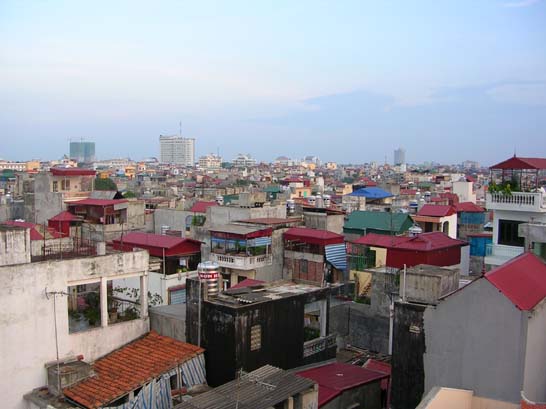
For breakfast, we go to a kind of restaurant called Koto, which is supported by the tour guide, who always takes us there. Koto is also a social institution, founded several years ago by an Australian with the goal of getting children off the streets and giving them the opportunity to receive training in the hospitality industry and also to attend school. However, the “social institution” is hardly recognizable as such; it resembles more of an upscale restaurant.
It makes a fine impression both inside and out, and is beautifully decorated. For three and a half euros, you get a huge and delicious breakfast: pancakes, spring rolls, omelets, cakes, bread, and as much fruit as you like. The young waiters wear Eastern-style uniforms and are, without exception, extremely courteous.
Of course I visit the “father” of Vietnam: Ho Chi Minh

There’s one monument I definitely want to see, because it connects old and new Vietnam: the mausoleum of the Viet Cong leader and founding father of today’s communist state, Ho Chi Minh. Officially, he’s known as “Uncle Ho.”
The security measures are impressive. We’re not allowed to bring anything metallic, weapon-like, or recording devices. Ha stays outside and keeps our belongings safe. She’s quite impressed when I hand her my Canadian hunting knife along with my camera.
We have to stand in an endless line. In front of us is a uniformed group of young Boy Scouts, who eye me curiously and giggle. Behind us stands a large group of uniformed Japanese tourists with red caps and a guide. But security guards don’t miss a chance to make us Westerners fry in the sun, repeatedly stopping the line around us to make room for someone from another direction.
When we finally reach Uncle Ho’s tomb, it’s a relief, as there’s air conditioning. Visitors can follow the line up the stairs past soldiers and walk around his coffin. Uncle Ho lies somewhat pale, illuminated by bright yellow spotlights in a large, bare marble room in a glass coffin lined with pillows and blankets. The Vietnamese and communist flags hang above his coffin.
Check out more of my juvenile trip through Indochina!
Back outside, we visit “Uncle Ho’s” palace (where he never lived), his car, his office, and his park. And his museum. My guide, Ha, does a brilliant job. At lunchtime, we meet her again for a cyclo tour through Hanoi. There are generally very few options for getting around here. You can walk, but even with a map, I got completely lost within a few streets. I once saw a bus, but not even the Vietnamese know where it stops or where it goes. Then there are cyclos, small bicycle rickshaws, where the passenger sits at the front, in the front row, eye to eye with the traffic. At least they’re the first to be hit. These cyclos are comfortable and cheap, but woefully slow. Motorcycle taxis are faster. You don’t recognize them as such, but the drivers will chat you up every 30 seconds as you walk through the streets.
You can also approach any motorcyclist; in fact, every scooter owner is a taxi. These scooters are fast and risky. As you weave through traffic, your life passes by as quickly as the red lights.
And there are also regular four-wheeled taxis. These are clean, but I’ve had trouble with every taxi I’ve ever taken. One taxi was supposed to take me to a camera shop, but I couldn’t find the address or directions on the back of the business card. Finally, with our help, it arrived, but at a snail’s pace, and I argued with the driver for ten minutes because I refused to pay the full price. It worked.





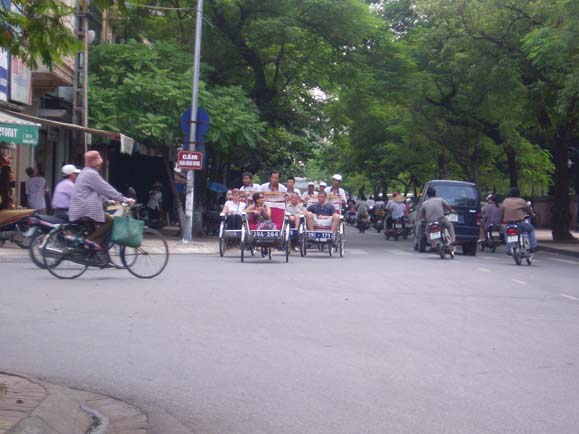

The next taxi driver was supposed to take me to the Hanoi Hilton—a prison from the French colonial era. Instead, he dropped me off at the Museum of Ethnology.
The last taxi driver suddenly wants four thousand dong more than his meter reads. Nice try…
My cyclo tour goes through the old town of Hanoi, through narrow streets and alleys.
We stop and I stroll through the markets and visit an art studio.
At the end of the three-hour tour, we arrive at B-52 Lake, named after the bomber that was shot down during an air raid over Hanoi and crashed in the middle of this lake in the city. Its wreckage still protrudes from the water.
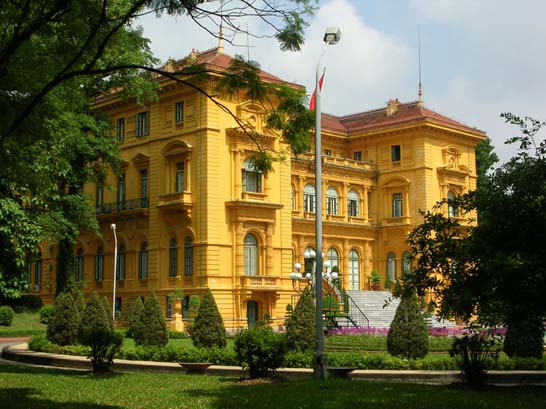


I continue my tour with Jane for a visit to a camera shop. We have a pleasant dinner on the roof of a high-rise building, overlooking a lake and the city—where a music video for a well-known Vietnamese singer is being filmed—before we meet up with the others again at a theater. It’s a special water puppet theater. It’s not large, and the stage is flooded with shimmering green water. Above the water is a large Asian castle, a curtain, and small gates on the sides. Next to the stage, there’s a small band on a platform. The musicians play beautiful Asian melodies with flutes and small string instruments.
I couldn’t help thinking of the soundtrack from The Last Samurai. After giving a short concert, they play along to the movements of the puppets emerging from behind the curtain. They are small, beautifully animated dragons, the imperial court, fishermen fishing for wriggling fish puppets, cats chasing the fish away from the fishermen, fishermen chasing cats, and fishermen chasing fisherwomen.
After the show, we go back to the bar on the skyscraper to have a view of Hanoi at night.


I ruin the next morning for Glen, a sleepyhead, and me by accidentally setting the alarm an hour early. Glen values his sleep well. And he’s in the Navy…
I stroll through the streets a bit with the Scots and the New Zealand Australians. Besides motorcyclists, we’re often approached by vendors who want to sell us books, pendants, fans, or similar items. And even children do the same. But they never beg.
We quickly got lost in all the shops. Another typical feature of Vietnam is that shops with the same products are conveniently located next to each other. Entire streets sometimes sell watches, others trousers, and still others souvenirs. Books are generally copied, as are the trousers and watches.
At lunchtime, I meet up with the others again, and we decide to visit the Hanoi Hilton. This was once a French prison, but was taken over by the Vietnamese shortly afterwards. It was jokingly called the Hanoi Hilton. The North Vietnamese also held American pilots here. The museum tries to clearly demonstrate how horribly the French mistreated them. You can see two guillotines, the cramped cells, and the statistics on how many prisoners the French killed and mistreated. In contrast, the American rooms show how well they were looked after. They were allowed to receive gifts, mail, and visitors, and were immediately sent home after the war. Ironically, a real Hilton hotel was built right next to the prison after the war.


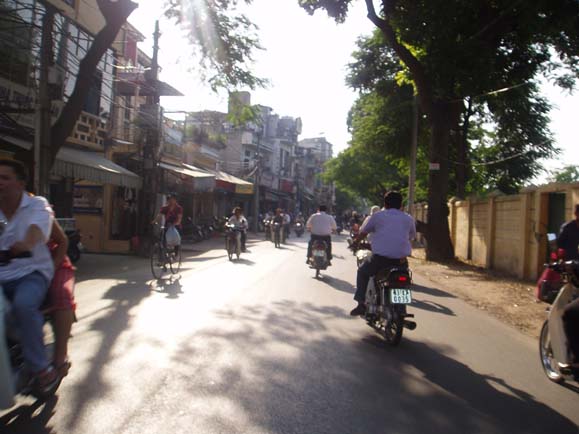
From the hotel, I wander a bit through the streets on my own. In the evening, we meet again to take the night train to the ancient royal city of Hue. This time, there’s no disco on the train. The cabins are small and cramped, and everyone has to share them with strangers.
The air conditioning is also set way too cold, and constant loudspeaker announcements and music make this sleeper car ride an ordeal. We arrive in Hue the next day feeling pretty exhausted.
